The other talc products you should know about in the wake of the baby powder scandal


Johnson and Johnson has been found to know of asbestos in its baby powder. Photo: Getty
The “family company” Johnson & Johnson is forcefully denying a media report that it knew for decades its baby powder sometimes contained small amounts of asbestos.
Reuters has released documents claiming consulting labs as early as 1957 and 1958 found asbestos in the “silky and soft skin” product made with talcum powder.
Further reports by the company and outside labs showed similar findings through the early 2000s, but the product has remained on supermarket and pharmacy shelves.

Johnson & Johnson baby powder. Photo: Getty
Plaintiffs used the documents as part of a successful lawsuit in July this year, claiming the product can be linked to ovarian cancer.
Twenty-two women and their families argued Johnson & Johnson knew about the connection between talc and asbestos, and a jury in St Louis, Missouri, awarded them $US4.69 billion ($6 billion).
Johnson & Johnson is appealing the verdicts which it said were the result of an unfair process. It has repeatedly denied the link between talc and asbestos, while battling more than 10,000 cases claiming its products cause ovarian cancer.
The US-based company called the Reuters report “one-sided, false and inflammatory”, adding “thousands of independent tests by regulators and the world’s leading labs prove our baby powder has never contained asbestos”.
The Reuters report sent the company’s shares into a tailspin, with the company suffering a 10 per cent fall, its worst one-day sell-off in 16 years
But it’s not just baby powder that contains talcum
Talc is a mineral in clay mined from underground deposits and is used in a wide range of cosmetic, commercial and industrial products.
Composed of magnesium silicate, the softest material known to man is used in countless cosmetics, including lipstick, mascara, face foundation, eyeshadow palettes and blush to create a rosy glow.
Talc is also used as an ingredient in food processing, and to make some supplements, pharmaceutical pills, chewing gum and polished rice.
On the ingredients list, it can be listed as talc, talcum or talcum powder, cosmetic talc or magnesium silicate.
As late as the 1990s, talcum powder was applied to surgical gloves and condoms in the United States, while industrial talc is often used to produce ceramics, plastics, paper, roofing, flooring and rubber.

People throw talcum powder during the street carnival Los Indianos in Santa Cruz de la Palma, on the Spanish Canary island of La Palma. Photo: Getty
The New York Times also reports that consumer groups have also detected the mineral in children’s crayons and amateur crime lab kits, in the form of finger-printing powder.
The problem? Veins of asbestos fibres – a known carcinogen – can often be found in talc deposits underground, creating a risk of cross-contamination, according to geologists.
Is talcum powder safe?
The Cancer Council of Australia says there is “inconclusive evidence” using talcum powder can cause cancer, and further research is needed to determine how talcum powder might increase the risk of ovarian cancer.
“The evidence is so tenuous that is hasn’t justified any health authority in the world to my knowledge, coming out with broad advice to women as a whole, or placing a warning label on talcum powder products or anything like that,” the cancer organisation’s Professor Bernard Stewart told the ABC.
However, paediatricians have long been warning parents to not use talcum powder on babies because children risk inhaling talc can cause respiratory illness or lung damage – completely irrespective of the potential asbestos exposure.
“Despite the potential dangers of talc aspiration, little has been done to publicise these dangers to the general public,” the American Academy of Paediatrics wrote in 1969.








